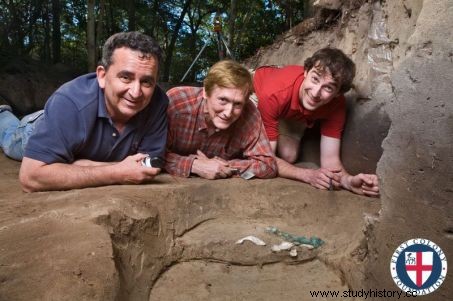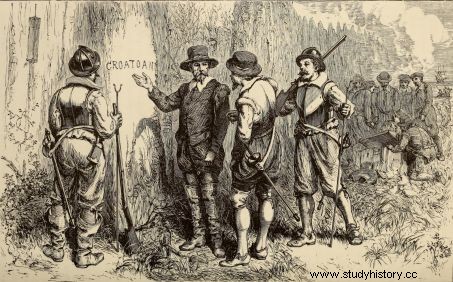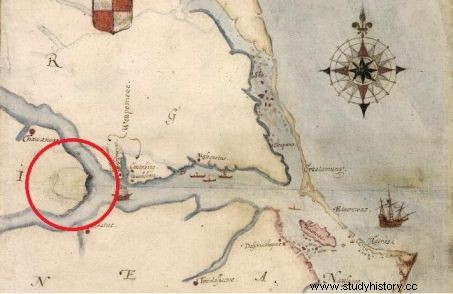It's one of the most enduring puzzles in US history, and it's right at its beginning:in 1587, the very first settlers from England vanished without a trace. But new findings suggest they may have taken refuge in native tribes to survive.

A map of Roanoke Island, second half of the 16th century.
Four hundred and thirty-five years after the "Lost Colony" disappeared from Roanoke Island, is one of the most famous mysteries in American history finally on its way to being unraveled? According to archaeologists from the First Colony Foundation, a non-profit organization that conducted new excavations 80 km west of Roanoke Island in January 2020, there is growing evidence that the first wave of English settlers on the American mainland continued to live in present-day Bertie County after it evaporated from the original encampment.
Two intriguing sites
The team led by independent archaeologist Nicholas Luccketi has indeed unearthed on a cliff overlooking Albermarle Bay, nicknamed "site Y", numerous fragments of English, Spanish, German and French pottery, which they believe constitute evidence that the site was inhabited by several members of Sir Walter Raleigh's colony after 1590, the year in which it was declared extinct by the Kingdom of England.
Between 2015 and 2017, a collection of artifacts including a sword hilt, broken bowls and a fragment of a slate tablet were also unearthed some three kilometers from "Site Y", at "Site X". , located on Hatteras Island. Excavations carried out by another team, that of Mark Horton, archaeologist at the University of Bristol, in the United Kingdom. Already at the time, Mark Horton had maintained that these vestiges considerably reinforced the thesis according to which the extinct members of the English colony had in fact assimilated with the Native American tribes of the surroundings, while retaining their property.

First Colony Foundation archaeologists Nick Luccketti, David Hazzard and Luke Pecoraro, posing in front of a necklace that may have belonged to the Roanoke Indians, here in 2008. Credits:First Colony Foundation
To fully understand what the discoveries and claims of these two teams of archaeologists imply, it is necessary to recall the sad story of these very first British settlers who landed on the North American coast to "populate the New World". P>
110 colonists abandoned by the Crown
Four hundred and thirty-five years after the "Lost Colony" disappeared from Roanoke Island, is one of the most famous mysteries in American history finally on its way to being unraveled? According to archaeologists from the First Colony Foundation, a non-profit organization that conducted new excavations 80 km west of Roanoke Island in January 2020, there is growing evidence that the first wave of English settlers on the American mainland continued to live in present-day Bertie County after it evaporated from the original encampment.
Two intriguing sites
The team led by independent archaeologist Nicholas Luccketi has indeed unearthed on a cliff overlooking Albermarle Bay, nicknamed "site Y", numerous fragments of English, Spanish, German and French pottery, which they believe constitute evidence that the site was inhabited by several members of Sir Walter Raleigh's colony after 1590, the year in which it was declared extinct by the Kingdom of England.
Between 2015 and 2017, a collection of artifacts including a sword hilt, broken bowls and a fragment of a slate tablet were also unearthed some three kilometers from "Site Y", at "Site X". , located on Hatteras Island. Excavations carried out by another team, that of Mark Horton, archaeologist at the University of Bristol, in the United Kingdom. Already at the time, Mark Horton had maintained that these vestiges considerably reinforced the thesis according to which the extinct members of the English colony had in fact assimilated with the Native American tribes of the surroundings, while retaining their property.

First Colony Foundation archaeologists Nick Luccketti, David Hazzard and Luke Pecoraro, posing in front of a necklace that may have belonged to the Roanoke Indians, here in 2008. Credits:First Colony Foundation
To fully understand what the discoveries and claims of these two teams of archaeologists imply, it is necessary to recall the sad story of these very first British settlers who landed on the North American coast to "populate the New World". P>
110 colonists abandoned by the Crown
In 1585, Sir Walter Raleigh, warlord, navigator and favorite of Queen Elizabeth I, obtained permission to establish a colony on the other side of the Atlantic to shade the Spaniards, present on the continent for more than 50 years already (but no doubt also in the hope of leaving its name in history). Three ships were sent in 1587 Virginia, the name given to these lands in honor of the so-called virginity of the queen… On board were massed 110 settlers, including 18 women, mainly craftsmen and farmers from the London area , who were each given 200 hectares of land.
A certain John White was appointed by Raleigh to lead the expedition and govern the colony. He did not hesitate to take his pregnant daughter Eleanor with him. And for good reason:his grandson or granddaughter would thus become the first English citizen to be born on American soil. In July 1587, the boats docked at Roanoke, an island that was actually far too hostile to establish a village there. At the mercy of storms, this area is still today nicknamed "the cemetery of the Atlantic". Barely a month later, in lack of food, White was forced to seek reinforcements in England and to leave behind his daughter and his granddaughter, Virginia, born a few days earlier and baptized thus in honor of shipping. Unfortunately, he did not return until three years later, the war with Spain having finally broken out upon his arrival in England.
In the early morning of August 18, 1590, John White, who had fought all this time to obtain permission to return to the aid of the colony, finally set foot on Roanoke again. But he found the camp deserted, as if tidy before a departure. Intriguing detail:the inscriptions "Croatoan" and "Cro" had been carved respectively on a post on the outer side of the palisade and on a tree. "Croatoan"...which is none other than the ancient name of Hatteras Island and the native people who inhabited it.

English relief finally arrived on Roanoke in 1590, finding only an abandoned village on the island and a word carved into a tree and a fence, "Croatoan", as shown in this 1876 illustration by William Ludwell Sheppard, engraving by William James Linton. Credits:Wikimedia Commons
What happened to these men and women who were left destitute for three years? No one ever discovered it, but there were many theories:scattered in the hope of surviving in small groups, they died of hunger and cold in the surrounding forest; massacred by native tribes; located by the Spaniards, who reserved a no less disastrous fate for them...
A new site kept secret?
So here we are back to our European pottery pieces, which could indicate that at least some of the extinct settlers survived, potentially splitting into two. "The number and variety of artifacts found clearly show that the site was inhabited by several members of Sir Walter Raleigh's colony which disappeared in 1587" , says Nick Liccketti. Especially since other clues seem to agree with this scenario.
In one of his earlier writings, White claimed that the settlers intended to move their camp "50 miles inland". But he himself was unable to locate them afterwards. At least that's what we always thought...until 2012, when researchers noticed an "anomaly" on a map drawn by White. Representing the eastern part of North Carolina, this one features a strange little patch of paper pasted over the image of a fort, at the tip of Albemarle Bay. A fort drawn in invisible ink and precisely located 80 km west of Roanoke.

The small piece of paper obscuring a fort and glued to a map made by John White himself, here placed under the light. Credits:Wikimedia Commons
Did White try to hide the location of a place he knew about? Perhaps, especially out of fear that the Spaniards would locate the new location of the colony. If this theory is true, then he might have been able to hug his little Virginia...
Sceptical voices
During recent excavations at this location, which today corresponds to site X, archaeologists did not find any fort. Only the famous English artifacts. Clues far too thin to claim that the Lost Colony had in fact survived, according to Charles Ewen, an anthropologist at Eastern Carolina University who has worked on the Roanoke enigma and is about to publish a book. on the subject. "Their interpretation is based solely on a handful of artifacts which, by their own admission, span the period from the late 16th to early 17th centuries. There are other ways in which these objects may have arrived on what appears to be a site of aboriginal occupation. Trade, for example. They have not yet uncovered any architectural remains or burials at these sites, which would be much better evidence of early European occupation" , confides the researcher to Sciences et Avenir .
Indeed, Border artefacts, baluster jars and North Devon shards, the types of pottery to which the fragments found belong, were also unearthed in Jamestown, present-day Virginia, considered the first permanent British settlement in the United Kingdom. American history (after Roanoke, therefore). And while archaeologists claim they are only found in small quantities in Jamestown because they were out of fashion then, "they may have continued to be used until the 17th century" , adds Charles Ewen. "That's why the ceramics alone don't make a compelling case to me. Especially since there was a large native village in the Roanoke area that had contact with the Europeans."
Many doors still open
For his part, Nick Lucketti argues that the European artifacts do not come from Nathaniel Batts, the only recorded European trader in the area in the early 17th century. So there wouldn't have been any other Europeans around, and the artifacts from Jamestown couldn't have gotten that far west. His team also defends the fact that Hatteras Island and its surroundings was a logical place of refuge for the colonists lost after the departure of John White:we know that the natives who lived there maintained friendly relations with the English. /P>
Other theories are also put forward by some researchers. One of them would like that the colonists left in other directions to establish themselves in other places, still not located. "In reality, when we have so little historical and archaeological data, we can deduce many scenarios, each as plausible as the other" , concludes Charles Ewen. It seems like the more you find, the less you know...
